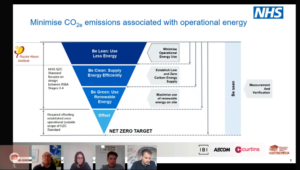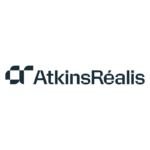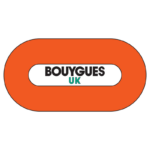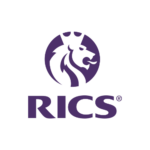Net-zero by 2030
Wales are well underway devising ways to deliver net zero by 2030. NHS Wales, in particular, are excelling in this, and lessons learned should be applied across other sectors such as education.
This presentation included a panel of speakers from IBI Group, AECOM and Curtins – all architecture and engineering firms. Topics ranged from NHS Wales’ projects the panel collectively worked on, Key Performance Indicators (KPIs) for decarbonisation and addressing embodied carbon in existing infrastructure to successfully reach net zero.

Learnings from Completed Projects
In early 2020, Welsh Government and NHS Wales questioned whether it was possible to decarbonise buildings that were part of the Design for Life healthcare framework. There was a lot of ambiguity around this, as there is often an automatic assumption that ‘net zero’ solely relates to operational carbon. However, it additionally applies to embodied and whole life carbon. It is important to remember that by 2030 the majority of a building’s carbon footprint will be embodied; ways to reduce embodied carbon must be considered now, so by the time we reach 2030 the impact is more manageable.
IBI, AECOM and Curtins developed a timeline to achieve net zero. Multiple projects have since been delivered. For instance Tredegar HWB Centre, which specifically tackled embodied carbon. Simply evaluating and reducing the substructure, concrete used and retaining walls, the building reduced from 1,200 kilogrammes of carbon dioxide emitted per square meter (kgCO2e/m2) annually to 1,000 kgCO2e/m2. A more recent project, Nevill Hall Hospital’s Abergavenny Satellite Radiotherapy Unit, reduced annual emissions by a third from 1,500 kgCO2e/m2 to 1,075 kgCO2e/m2. Despite having dense concrete Linac bunkers to prevent radiation escaping, this decrease was possible through careful design from the outset.
This one third reduction should arguably be the minimum KPI target for combatting embodied carbon. Reduction can be achieved through methodologies like Passivhaus, Modern Methods of Construction and materials used to lower both operational and embodied carbon, and ultimately improve health, well-being and safety.
Actions to Accelerate the Journey to Net Zero
It is important to devise KPIs for all aspects of carbon reduction: operational, embodied and whole life. NHS Wales have played a significant role in kickstarting this journey, however Wales’ Department for Education will be critical in introducing KPIs and requirements for the education sector to meet. Until KPIs are delivered, it will be difficult to understand a project’s performance and areas that need to be refined. A way to incentivise net zero would be the introduction of carbon (or ‘polluter pays’) tax. For instance, London’s Energy Assessment Guidance scheme which includes a fine of £95 per tonne of residual carbon in a building. It is likely Wales will introduce a similar scheme. Following a whole life cycle and circular economy approach could play a significant role in achieving net zero, through recycling components and materials both externally and internally. One member of the panel provided an example of a project where timber from a school’s gym hall was reused as cladding in their new building. To put it one way: we need future buildings to be like Lego; where components can be put together and easily taken apart and subsequently used elsewhere.
The panel concluded that three main areas should not be neglected when designing and delivering net zero buildings. These were: agreeing project specific metrics from the outset; knowing we can achieve net zero operational carbon now; and with regard to embodied carbon, collaboration and reporting data will be crucial to offset carbon and truly achieve net zero.

Written by Holly Passmore, Thought Leadership Consultant, Step Connect2
To Stream this Webinar On-Demand CLICK HERE.











